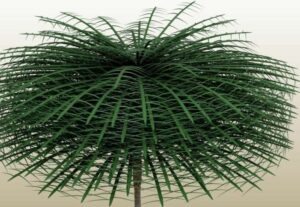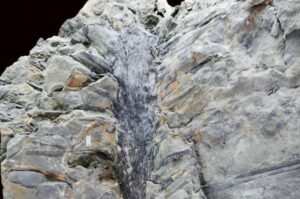Introduction: Exploring the Enigmatic World of Ancient Trees
In the annals of paleontology, fossilized trees often reveal only part of the story, their trunks devoid of leaves, leaving researchers to speculate about their true form and function. For centuries, the study of ancient flora has been hindered by this lack of complete preservation, with our understanding of prehistoric ecosystems limited by the incomplete picture provided by petrified trunks.

However, a recent breakthrough in New Brunswick, Canada, has shattered these limitations and opened a window into a world previously unseen. Here, amidst the rugged landscape, researchers have unearthed rare 3D fossils that defy conventional expectations and challenge our understanding of early arboreal life. These extraordinary specimens, identified as Sanfordiacaulis, offer a glimpse into a bygone era, where trees took on shapes and forms unlike any seen before, rewriting the narrative of ancient plant evolution and providing tantalizing clues about the ecological dynamics of the distant past.
Unprecedented Discoveries: The Astounding Forms of Sanfordiacaulis
Led by Robert Gastaldo of Colby College, a team of international researchers has uncovered a treasure trove of 350-million-year-old fossils exhibiting a breathtaking three-dimensional crown shape. These specimens, identified as Sanfordiacaulis, defy categorization, bearing a striking resemblance to a fusion of ferns and palms yet predating the latter by 300 million years.
Their findings represent a significant departure from conventional expectations, challenging established notions of ancient plant morphology and prompting a reevaluation of early arboreal diversity. The remarkable resemblance of Sanfordiacaulis to modern ferns and palms suggests an unexpected convergence in evolutionary trajectories, hinting at complex ecological dynamics in prehistoric ecosystems. As researchers delve deeper into the mysteries of these ancient specimens, they unravel a tapestry of evolutionary experimentation and adaptation that reshapes our understanding of Earth’s botanical past
Beyond Expectations: The Astonishing Canopy of Sanfordiacaulis
Unlike their modern counterparts, Sanfordiacaulis trees boasted an extraordinary array of over 250 leaves per trunk segment, each extending approximately 1.75 meters. This unparalleled density of foliage created a dense canopy spanning at least 5.5 meters around a surprisingly slender, non-woody trunk, challenging preconceived notions of ancient tree morphology.

This revelation underscores the remarkable adaptability of early plant life and suggests that environmental conditions in the Early Carboniferous period may have favored unique growth strategies. The sheer abundance of leaves on Sanfordiacaulis indicates an efficient utilization of resources, perhaps driven by competitive pressures or ecological opportunities present in its ancient habitat. As researchers unravel the intricacies of this ancient arboreal marvel, they gain invaluable insights into the evolutionary forces that shaped Earth’s vegetation millions of years ago, shedding new light on the dynamic interplay between plants and their environment throughout geological time.
Collaborative Endeavors: Unraveling the Mysteries of Ancient Flora
Through a long-term collaboration with researchers from the New Brunswick Museum and Saint Mary’s University, the team pieced together the puzzle of Sanfordiacaulis, shedding light on its evolutionary significance and ecological adaptations.
This collaborative effort exemplifies the importance of interdisciplinary research in uncovering the secrets of ancient life forms. By combining expertise from paleontology, botany, and ecology, the team was able to reconstruct the ecological context in which Sanfordiacaulis thrived and infer its role within ancient ecosystems. Through meticulous analysis of fossil specimens and comparative studies with extant plant species, they elucidated the unique adaptations that enabled Sanfordiacaulis to flourish in its prehistoric environment. This holistic approach not only deepens our understanding of ancient plant evolution but also highlights the interconnectedness of life forms across geological time, underscoring the importance of collaboration in unraveling the mysteries of Earth’s history.
Unprecedented Preservation: Unlocking the Secrets of Earth’s Past
Preserved by a cataclysmic event induced by earthquakes along the margin of a rift lake, these rare fossils offer a unique window into a prehistoric world teeming with botanical wonders. Discovered over the span of seven years, each specimen adds another layer to our understanding of ancient arboreal ecosystems.
The remarkable preservation of Sanfordiacaulis fossils provides a snapshot of a moment frozen in time, capturing the intricate details of ancient plant life that would otherwise have been lost to the ages. The catastrophic burial event that entombed these trees in sediment offers insights into the geological processes that shaped the landscape millions of years ago, providing valuable context for interpreting the fossil record. As researchers painstakingly extract and analyze each specimen, they peel back the layers of time, revealing the hidden stories encoded within the petrified remains of these ancient trees. In doing so, they piece together the puzzle of ancient arboreal ecosystems, offering glimpses into the diversity and complexity of life that once thrived on Earth’s surface.
Anomaly Amidst the Fossils: Intact Crown Leaves Defy the Odds
Of particular intrigue is the discovery of a specimen with intact crown leaves still attached to the trunk, a rarity in the fossil record spanning millions of years. This anomaly prompts profound questions about the nature of early tree forms and their ecological strategies, challenging conventional interpretations.
The preservation of crown leaves offers a unique opportunity to peer into the past and observe ancient trees in their full glory, providing invaluable insights into their growth patterns and ecological interactions. This exceptional find raises intriguing questions about the mechanisms of fossilization and the conditions required for such remarkable preservation. Moreover, it invites speculation about the ecological significance of intact crown leaves and their role in the ancient forest canopy. As researchers delve deeper into this enigma, they uncover clues about the evolutionary trajectories of early tree forms and the environmental pressures that shaped their adaptations. In unraveling the mysteries of this extraordinary specimen, scientists embark on a journey to unlock the secrets of Earth’s ancient forests and illuminate the pathways of plant evolution through time.
Insights into Ancient Ecology: Sanfordiacaulis and the Evolution of Forest Canopies
Researchers posit that Sanfordiacaulis likely leveraged its unique growth form to maximize light capture and minimize competition with ground-dwelling plants, offering a glimpse into the complex interactions shaping Early Carboniferous ecosystems.
Concluding Remarks: Reflecting on Earth’s Dynamic History
As we unravel the mysteries of ancient life, rare and unusual fossils like those of Sanfordiacaulis serve as poignant reminders of the diversity and dynamism that have characterized our planet’s history. While some evolutionary experiments may have ended in obscurity, each discovery adds another chapter to the ongoing saga of life on Earth.
